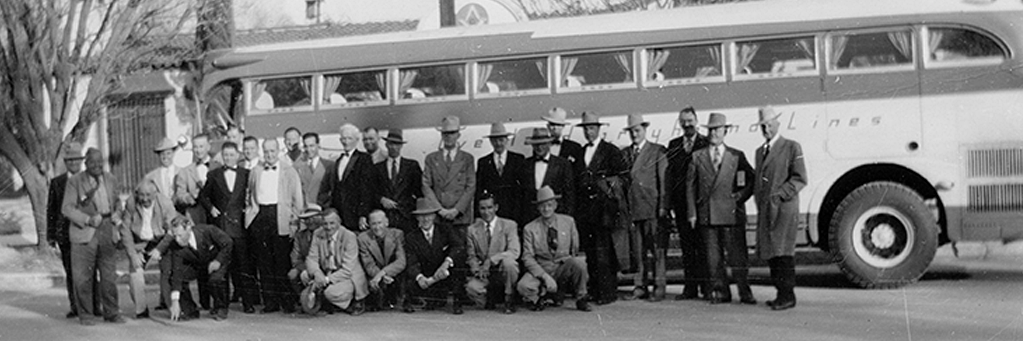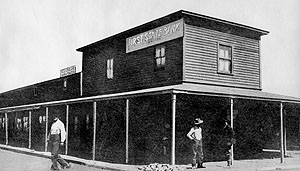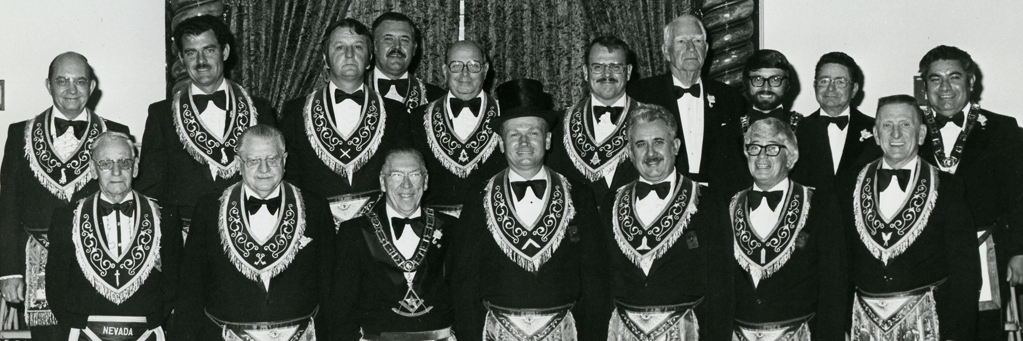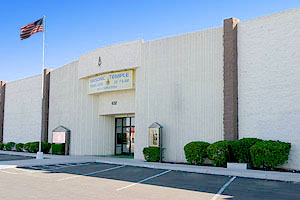Vegas Lodge #32 F&AM, orVegas 32 as it is called by friends and members, with a charter dating back to June 9th, 1908, holds the distinguished honor of being the oldest Masonic Lodge in Southern Nevada, serving the community for over 100 years.
Some Brothers simply enjoy the dramatics, some focus on the management and administration of the lodge, others explore the history, ritual and symbolism of the craft, some focus their involvement on the lodge’s sociopolitical side, perhaps in association with other lodges, while others may concentrate on the lodge’s unique and notable charitable functions.

History of Masonry in Nevada
Written by C.W. Torrence, Published 1944 by the Grand Lodge, F.&A.M. of Nevada.
The opening of Clark’s Las Vegas townsite was the occasion of some interesting developments, one of which was the eventual establishment of a Masonic lodge in the district. It has been said that Masonry was almost an outgrowth of the soil in the new townsite. When it came nobody knows, but Masons were there when the crowd gathered to purchase and settle in the new district, and from that time forward, Masonic history began its lofty career near the rushing tide of the Colorado River in Las Vegas district.
It is only natural to assume, that among this flood of humanity which surged toward this oasis in the desert, lured by the commercial and industrial possibilities offered, the Masons who had gathered here, with the ebb of the tide, were impelled to group themselves into a body whereby Masonic light might be diffused, and it was only a natural assumption that the establishment of a Masonic lodge in Las Vegas would make for law, order and morality, as it had always done in other newly established districts; for with the tide, had drifted those of the underworld, some of whom were not regarded, nor wished for as citizens, and in other sections of the country where this element had held sway and into which communities Masonry had been introduced, the influences of the craft, and the standing of its membership united to eventually rid these communities of their undesirables. Nor was Las Vegas an exception to the rule, for it must be remembered that the Masons who had gravitated into this thirsty, arid section of the country were men of outstanding moral and constructive abilities, well qualified to guide the destinies of a people who had gathered to establish a new community and to develop its resources, some of whom were to occupy places of honor and positions of responsibility in municipal, county and state affairs. Soon the members of this small group, who had found Masonic light in other jurisdictions, were augmented by other arrivals, and Masonic representation here was sufficient to warrant the brethren to ask for authority to establish a lodge under dispensation.
It has become Masonic tradition in the Las Vegas lodge that as early as July, 1905, these brethren had endeavored to formulate plans whereby Masonry in the district might become a reality in the establishment of an active lodge, but owing to the fact that the town was in the process of becoming established, and the population was more or less of a transient character, it was deemed advisable to await for more favorable conditions before applying for a dispensation. The delay incident to this decision lapsed into months, and the spring of 1907 was at hand before further action was taken, at which time fifteen resident Masons of Las Vegas, most of whom are said to have been living in the district before the promoting of Clark’s townsite, made application to the Grand Lodge of Nevada for a dispensation. The movement was headed by Brother John S. Park, with the assistance and support of Brothers E. W. Griffith and William R. Thomas, all of whom, by virtue of their service in the order, were qualified to guide the fraternal baroque upon the uncharted sea of Masonry in the district. Associated with them were A. N. Pauff, Waiter R. Bracken, Henry M. Lillas, Roy C. Thomas, Benjamin F. Boggs, Rev. J. W. Bain, Charles F. Towner, Frank A. Buol and E. T. Maxwell, all of whom were intimately associated with the professional and commercial activities of the town, and who at one time or other had been actively engaged in Masonic service in other jurisdictions. The application for dispensation was addressed to Most Worshipful Robert Lewers, Grand Master of Nevada Masons. With the granting of the dispensation, Brother John S. Park was named Worshipful Master, Edw. Griffith Senior Warden, and William R. Thomas, Junior Warden.

In the meantime, plans were also started to acquire and furnish suitable quarters in which to hold their meetings, and to spread Masonic light. As a result of these endeavors, quarters were found on the second floor of the First State Bank located on the north side of Fremont Street, and furnished comfortably; in which this embryonic unit of Masonry might hold forth. In this connection it is interesting to note the activities of Brother John S. Park, the first master of the lodge. If I may quote from a letter received from Past Grand Master W. S. Park, dated January 13, 1937, Brother Park says, “My father organized the brethren here and established Vegas Lodge 32. He was its first master, and was connected with the bank here and through his efforts the bank constructed a two story building 110 by 40 feet. The street floor was used as a grocery store; the upstairs was constructed primarily for the use of the lodge. There was a stage in the building and in the early days was used as an opera house.”
The building was offered the lodge for $18,000 when completed – no down payment – and the bank guaranteed that it would pay out in eight years. The offer was declined. The property is now (1944 – ed.) worth about $50,000. Continuing, Brother Park says, “It may be of interest to note that Brother William Mundy was the first candidate initiated an entered apprentice, and I was the first candidate raised in Vegas Lodge.” At an informal meeting in this building in early 1907 the following named brethren were tentatively named to officer the lodge under the dispensation: John S. Park, W. M.; Edw. W. Griffith, S. W.; Walter R. Thomas, J. W.; A. N. Pauff, Secretary; Walter R. Bracken, Treasurer; Henry M. Lillas, S. D.; Roy C. Thomas, J. D.; Benjamin F. Boggs, Tyler; Rev. J. W. Rain, Chaplain. It was also planned to celebrate the receipt of the dispensation with an appropriate program, and the officers named were installed into office by Brother Walter E. Brown, who had been duly authorized to institute and install its officers. Later, Grand Master Robert Lewers spent some time with the lodge on different occasions, and it was on one of these visitations that Vegas Lodge was presented its charter, and constituted a regular unit of the constituent lodges of Nevada.
In the Grand lodge proceedings of 1908, held in Reno, June 9, 1908, appears the following statement in the report of Grand Master Lewers: “At Las Vegas, I had the pleasure of meeting all the officers of Vegas Lodge U. D. at a delightful dinner given by Brother John S. Park, the very capable master. It was a satisfaction to find that the brethren asking the dispensation were all men of high standing in their community. Brother John S. Park has been instrumental in building a fine hall for the use of the brethren. I earnestly recommend that a charter be given this lodge.”
In compliance with this recommendation, the following resolution was introduced and adopted at the Grand Lodge communication held in Reno in June, 1908, viz: “Resolved that a charter be granted to Vegas Lodge No. 32, situated at the town of Las Vegas, Lincoln County, Nevada.” J. C. Doughty, F. C. Springmeyer, G. Seibert, Committee on Charters.
That the judgment of Grand Master Lewers had been sound in granting the brethren at Las Vegas a dispensation to organize a lodge of Masons, and that the committee on charters had also been wise in recommending the issuance of a charter to these brethren, and that the new lodge had been busy since its institution is evidenced by the numerical returns by lodges appearing in the 1908 proceedings, which reflected that, since the date of its dispensation, fourteen members had been raised to the sublime degree of Mason, and new applications were under investigation.
With the passing of the months, Vegas lodge continued to give a good account of itself, showing advancement, not only numerically, but by reason of the unselfish, consistent and devoted service of its members, inspiring confidence in the minds of the profane, and exciting admiration in those who contemplated seeking admission within its ranks, with the result that many petitions crossed the secretary’s desk, the trestle board was filled with work, and the membership roster reflected the names of many of the substantial citizens of the community.
From the organization of Vegas Lodge in 1907 until 1911, the brethren held their meetings in a building erected by the First State Bank, previously referred to. The second story was devoted to the use of Masonry and is dear to the heart of many Masons in the southern part of the state who received their degrees in this quaint lodge room, which is said to have been approximately twenty by twenty four feet in size, the entrance to which was up a stairway through a trap door which, when lowered, became the door of the preparation room.
Early in 1911 the lodge moved to the second door of a newly completed building at the corner of First and Fremont streets which later burned down; not, however, after the lodge had again moved to the second floor of a frame building known as Economy Hall, owned by Adolph Levy. Here, the lodge was quartered until about 1915. In the meantime, Judge Thomas of Las Vegas, had erected the Mesquite building at the southeast corner of First and Fremont streets, designing part of the second story as a Masonic lodge room. In 1915 the lodge moved from Economy Hall and established itself in Mesquite Building. The lodge room was located in the southeast corner of the second floor and consisted of an auditorium and two antechambers. Here it was able to maintain exclusive quarters, and in this building, built of cement blocks and located in the heart of the business district, it continued to expand and thrive.
“For many years there was a desire to erect a lodge-owned temple, but the time was never propitious; finally, during the year 1935, more definite plans were advanced, and the project actually started. On September 2 of that year, Brother Bud Barrett outlined a building program. The matter was discussed at the regular meeting of the month and it was decided that the trustees of the lodge be instructed to take the necessary steps to arrange for the sale of a bond issue, not to exceed twenty thousand dollars, bearing five percent interest, for the purpose of erecting a Masonic temple; these bonds were to be guaranteed by the lodge at such time as fifty-one percent of the membership favored the proposition. At this same meeting it was voted that the trustees be empowered to purchase a site for building the temple.
On November 4, 1935, Brother C. D. Breeze was employed as attorney to arrange the legalities of buying and building. On May 16, 1936, the corner stone was laid by Vegas Lodge at 215 S. Third Street acting under dispensation from the Grand Lodge of Nevada.
The lots purchased as the site of the temple are those designated as Lots 7, 8, 9, 14 Block 29, Vegas townsite, and are located on Third street between Carson and Bridger. On September 6, 1935, it was voted to enter into negotiations with Mr. A. C. Delkin, administrator of the estate of James H. Ladd for the purchase of these lots, the amount paid being $2,808.28. This property adjoins the land held by the American Legion which at one time had attempted to secure 25 feet of the property now owned by the lodge.

Details of the new building may be summarized as follows: Architect, Orville Clark, Los Angeles, California; contractor, Brother C. W. Jorgensen of the Vegas lodge. The architecture employed in the building embraces the Spanish type; the construction is of cement blocks and pitched tile roof. The building houses eighteen rooms, including the lodge auditorium, banquet room, kitchen, lounge, ladies’ and gentlemen’s rest rooms, Tyler’s room, examination room, furnace and utility rooms.
During the negotiations and building of the temple, Brother Bud S. Barrett served as Worshipful Master; Wm. Mundy, Earl Davidson and Fred Callaghan as trustees; K. O. Knudson, chairman of the building committee. With few modifications over the years, that beautiful Temple served the Lodge well for over 45 years. Many assembled here today began their Masonic journey within the hallowed halls of that building, and will cherish those memories forever.
As the years rolled by, however, the need for a larger Temple became more and more apparent, and the subject was discussed with increasing frequency at our stated communications. The first real step towards our new Temple was taken in 1972 when the Trustees purchased the property located at 632 E. Charleston Blvd. Although the Lodge considered a variety of options during the intervening years, all of them had to be abandoned for one reason or another.
But, all good things come to those who wait, and it seems particularly appropriate that we were able to proceed with the building during our Diamond jubilee year, of which on September 9, 1982 the new building at 632 E. Charleston Blvd was dedicated. It also seems particularly appropriate that the temple is located on the property once owned by our own Past Grand Master Dr. William S. Park. It was here that he and Mrs. Park, two people who contributed significantly to the growth of the Masonic community of Southern Nevada, made their home for many years.

